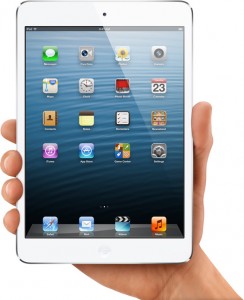As the rumors grew more intense and details began to leak from production line sources about the reality of Apple’s new device, it became fairly common to see “hold off on any purchases until the iPad Mini is ready” posted as advice. There is even reason to believe that many people took that advice, it turns out. Amazon put out a statement recently indicating that the 24rd of October (One day after Apple’s iPad Mini launch event) was “the $199 Kindle Fire HD‘s biggest day of sales since launch”.
Some of the lack of interest in the iPad Mini has to come from its shockingly high price. At $329 for the basic unit it is hard to compete with the $199 Kindle Fire HD in a market oriented toward people wanting to spend less for their tablet. That extra $130 is a huge step above the prices of 7” tablets that Apple has openly shown they intend to compete with.
 More importantly, the Kindle Fire HD has a superior display. Now display isn’t everything, but it’s a lot. Apple has largely maintained their advantage in tablets by offering some of the best visual performance money can buy. A tablet, like a smartphone, is basically a handheld screen; nothing could be more apparent as a selling point. Amazon and Google have had to price their tablets at cost in order to compete with the iPad up until now, but with better prices AND better visuals the competition is more than weighted against Apple for once.
More importantly, the Kindle Fire HD has a superior display. Now display isn’t everything, but it’s a lot. Apple has largely maintained their advantage in tablets by offering some of the best visual performance money can buy. A tablet, like a smartphone, is basically a handheld screen; nothing could be more apparent as a selling point. Amazon and Google have had to price their tablets at cost in order to compete with the iPad up until now, but with better prices AND better visuals the competition is more than weighted against Apple for once.
The spec comparisons largely go in this direction. Apple cut so much out of their device that just about all it has going for it is the slightly larger screen size (7.9” vs 7”) and the name “iPad”.
It’s possible that the iOS ecosystem will overcome these deficits. It certainly will be the biggest factor in driving sales. As more and more developers optimize their apps for the iPad 3’s A5X processor and the iPad 4’s A6X processor, however, people using the iPad Mini’s A5 processor might find their experience increasingly lacking. Anecdotes of iPhone 4 owners unhappy with the problems created by iOS 6 performance are common enough to make this particularly important. We’re talking about a device using roughly the same technology as the iPad 2 at a time when the iPad 4 is headlining.
There is still every reason for Amazon to be concerned about their chances in the larger tablet market. The 4th Generation iPad was updated to compete with the sort of powerful Windows 8 tablets beginning to hit the market and it is hard to imagine that even the $200 price difference in favor of the Kindle Fire HD 8.9” will be enough to drive sales in the face of those competitors unless Amazon does some serious expansion of their content ecosystem before the November 20th release date. Learn how to open JSON file.
In terms of smaller tablets, it’s fair to say that the big names to watch right now are Google, Amazon, and maybe Barnes & Noble. Apple has priced their option right out of the running, given what it’s made of. As much as I like the Kindle Fire, it would have been great to get some even more intense competition to push things forward. It’s a disappointment that Apple didn’t come through here.